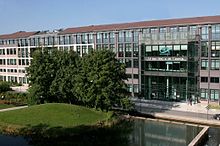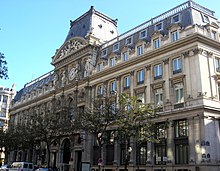Before the letter and attach
copy right - https://en.wikipedia.org -
Crédit Agricole in the 21st Century
The headquarters of
Crédit Lyonnais, which was acquired by the Crédit Agricole Group in 2003
Picking up the pace of business diversification 2001 - 2008
The 21st Century saw the group continue to diversify its business line-up.
Finaref was acquired in 2003. That same year, Crédit Agricole acquired Crédit Lyonnais in a
friendly takeover orchestrated by then Chairman of the Board
René Carron after a market battle was triggered by the government’s decision to auction off its stake in Crédit Lyonnais in December 2002. The two banks were combined in 2003 and 2004, which led to the different business lines being grouped into subsidiaries. This included the creation of Calyon in 2004 from the merger of the corporate and investment banking activities of Crédit Lyonnais and Crédit Agricole Indosuez. Crédit Lyonnais focused on retail banking and was rebranded as
LCL in August 2005.
Between 2004 and 2005, the Regional Banks and Crédit Agricole S.A. embarked on a major development plan aimed at bolstering the Regional Banks’ leading positions in France by gaining a greater presence in major cities, while at the same time increasing the Group’s international reach. Businesses were established in Egypt, Ukraine, Serbia, Greece, Italy and Portugal. In 2006,
Crédit Agricole Assurances was created to bring together the Pacifica and Predica brands.
In 2007, the group starting to part away from newly formed Italian banking giant
Intesa Sanpaolo, which Crédit Agricole was the largest shareholder of
Banca Intesa, despite on 22 January 2007 Crédit Agricole still acted as the third largest shareholder of Intesa Sanpaolo. On 1 March 2007 Crédit Agricole acquired 202 former Banca Intesa branches, as well as
Cariparma and
FriulAdria from Intesa Sanpaolo. In 2011 Crédit Agricole acquired Carispezia from Intesa Sanpaolo, as well as 96 branches directly from Intesa Sanpaolo. In 2012 Crédit Agricole finally sold all the shares of Intesa Sanpaolo.
Business overview
The group’s acquisitions enabled it to strengthen its leadership in French
retail banking, expand its position in corporate and
investment banking and build up its international network of branches and subsidiaries. By now, the group was the number-one bank in France with 28% of the domestic market, the global number-two by revenues and number-ten by profits, according to Fortune magazine, and number-15 worldwide according to
Forbes rankings.
Crédit Agricole and the 2008 - 2012 crisis
When the
interbank lending market seized up, Crédit Agricole was forced in January 2008 to sell its long-standing stake in
Suez for €1,3 billion and then in May 2008 to organise a €5.9 billion rights issue to which all the Regional Banks subscribed to meet
Basel II regulatory requirements. It also undertook a €5 billion programme of non-strategic asset disposals.
At the end of 2008, the government decided to loan France’s six largest banks €21 billion in two tranches, at an interest rate of 8%, to enable them to continue to play their role in the economy. Crédit Agricole did not take part in the second tranche
] and repaid the government in October 2009. Crédit Agricole’s crisis exit strategy was well received by the markets, with the share price gaining more than 40% over 2009.
In 2012, Crédit Agricole continued to report negative results, posting a loss of around €3 billion in the third quarter. The Greek branch
Emporiki was separated from its profitable wealthy parts in Albania, Bulgaria and Romania which were integrated into the Crédit Agricole group. The whole investment into Emporiki cost around €9 billion. The remaining Greek part was sold off to
Alpha Bank for €1. Crédit Agricole also withdrew totally from Spanish bank
Bankinter, resulting in a book loss of €193 million, and took a massive €600 million write-down on consumer credit, notably owing to difficulties in Italy.
[21] Furthermore, Crédit Agricole had to write down the
goodwill on its balance sheet. Goodwill amounted to €17.7 billion in September 2012, well above the actual value. In early February 2013, the bank announced that it would book €3.8 billion in writedowns and costs – a record amount according to the media.
Getting back to fundamentals from 2014
In March 2014, the Crédit Agricole Group unveiled its medium-term strategic plan
] which put the emphasis on retail banking, insurance and saving. Internationally, the group decided to refocus on its core markets, starting with Italy, the group’s second-largest market.
The Crédit Agricole Group sold its Bulgarian subsidiary to Corporate Commercial Bank for €160 million.On 22 April 2014, Crédit Agricole S.A., Crédit Agricole Nord and Crédit Agricole Nord-Est announced that they would sell 50% of their stake in Crelan S.A., a Belgian bank created out of the merger of Crédit Agricole Belgique and Centea, to Caisses coopératives belges by June 2015
Corporate governance
Crédit Agricole has a three-tier structure, comprising the Local Banks, the Regional Banks (and their branches and equity investments) and Crédit Agricole S.A. (and its subsidiaries). The Local and Regional Banks are cooperative companies. Crédit Agricole S.A. is a joint-stock company. Crédit Agricole is one of the leading cooperative companies in the world.
Local Banks
The 2,509 Local Banks form the foundation of Crédit Agricole. They have 7.4 million stakeholders (December 2013), who are both clients and owners of the share capital (through ownership shares) of the Local Banks, in accordance with the cooperative governance principle.
The Local Banks hold the bulk of the capital of the Regional Banks. At the annual general meetings of the Local Banks, which attract around 500,000 participants every year, the stakeholders appoint over 32,000 volunteer directors.
Regional Banks
Crédit Agricole’s Regional Banks are cooperative entities and fully-fledged banks, offering a wide range of financial products and services to their 20 million clients (end-2008). They boast a network of some 7,200 branches and 12,000 ATMs, plus more than 7,000 in-store cash points, which provide Crédit Agricole customers with basic banking services. Some Regional Banks have merged to improve their financial strength and competitiveness, with the total number of Regional Banks falling from 94 to 39 between 1988 and 2008.
- Preventing exclusion from banking services
To prevent customers affected by a personal event, such as a death or unemployment, from being excluded from banking services, 30 Regional Banks have set up Point Passerelle centres, which provide a friendly ear, mediation and support for clients looking for help to get out of a difficult situation. Caisse Régionale du Nord-Est first introduced the system in 1997.
- Promoting employment for people with disabilities
Through an association set up to promote the employment of people with disabilities within Crédit Agricole (HECA), the Crédit Agricole Regional Banks devote resources to the recruitment, integration and continued employment of disabled workers. Measures include workstation modifications, transport facilities and training. Since a lack of training makes it harder for people with disabilities to get work, Crédit Agricole has set up work/study training programmes to enable people who have their high school diploma to receive post-secondary qualifications. The goal was to recruit more than 800 disabled persons between 2006 and end-2010, and by end-2009, more than 360 permanent contracts and 670 work/study contracts had been signed.Former Miss France runner-up Sophie Vouzelaud, who has been deaf from birth, is HECA’s official ambassador.
- Promoting the cooperative model
The Regional Banks help to promote the cooperative model locally through a variety of initiatives, such as the Perspectives Mutualistes conference series (Pau in 2006, Angers in 2007, Reims in 200831, Orléans in 2009), and by issuing special bank cards for stakeholders.
Fédération Nationale du Crédit Agricole
Fédération Nationale du Crédit Agricole (FNCA) is the body through which the Regional Banks discuss policy, express their views and represent themselves. FNCA plays the role of a trade body. It is a forum for discussions that arise at the grass-roots level, and it plays a proactive, guiding role. It represents Crédit Agricole’s Regional Banks and the Group with respect to the public authorities, agricultural trade associations and bodies with authority for cooperative and mutual banking. FNCA provides services to Regional Banks, particularly in the fields of vocational training, through the Crédit Agricole Mutuel training centre, and human resource management. The senior management team is represented by:
- Dominique Lefebvre, Chairman of Fédération Nationale du Crédit Agricole,
- Philippe Brassac, Secretary General of Fédération Nationale du Crédit Agricole,
- Bertrand Corbeau, CEO of Fédération Nationale du Crédit Agricole.
Crédit Agricole S.A.

New headquarters of Crédit Agricole S.A. in
Montrouge
In 1988, Caisse Nationale de Crédit Agricole was privatised, becoming Crédit Agricole S.A., a public limited company owned by the Regional Banks and Group employees. In 2001, Crédit Agricole S.A. was floated on the stockmarket, although the Regional Banks (44 at the time) retained a majority share, as provided for by the group’s mutual articles of association.
- Senior management of Crédit Agricole S.A.
- Board of directors
The Board is made up of members elected by the Annual General Meeting, representatives of trade organisations, members elected by employees, a non-voting member and a representative of the Works Council.
- A complex structure
The Regional Banks own 54% of Crédit Agricole S.A., which in turn holds 25% of their capital in the form of non-voting cooperative securities (certificats coopératifs d'associés). An internal debate is continually underway on striking a balance between growing activities that serve the Regional Banks directly and promoting businesses that lie outside their sphere. Institutional investors, particularly in the UK and US, are not always at ease with this approach.
Brand identity
Slogan
- 1976 to 1987: “Le bon sens près de chez vous” ("Common sense close to home")
- 1987 to 1994: “Le bon sens en action” ("Common sense in action");
- 1994 to 2005: “L'imagination dans le bon sens” (“Imagination guided by common sense”);
- 2005 to 2011: “Une relation durable, ça change la vie” (“A lasting relationship changes your life”);
- Since 2011: “Le bon sens a de l’avenir” (“Common sense has a future”).
Visual identity
1948: the first official logo, conveying Crédit Agricole’s exclusive focus on the agricultural sector.
1959: Crédit Agricole adopts a second logo to express the firm’s strong involvement in the development of France42.
1971: third logo, combining the letters C and A.
1987: creation of the current logo, which summarises the group’s desire to continue to move forward and to favour openness towards the outside world.










